China built its own Tiangong space station, also known as “Tianhe”, located at altitudes of 217 and 280 miles (340 to 450 kilometers) in low Earth orbit in 2021. For the first time in more than four decades, it was China that brought moon rocks to humanity. China launched the Chang’e-6 probe to return soil from the far side of the Moon. The Chinese Academy of Sciences (CAS) Einstein Probe spacecraft was launched on January 9, 2024. China has already begun to lead the world in military launches, sending 45 defense satellites into orbit in 2022.
Tiangong Space Station
The crew of China’s Shenzhou 16 mission captured incredible images of the Tiangong space station during its return to Earth. The images, taken by a high-resolution camera, represent the first real images of the complete structures of the Tiangong space station since its arrival in orbit. Before landing, the Shenzhou 16 crew handed over control of the space station to the Shenzhou 17 crew, which arrived at Tiangong on October 26, 2023. The three taikonauts (Chinese astronauts) consisting of commander Jing Haipeng, Zhu Yanzhu and Gui Haichao then left the station.
On the way to Earth, the team pointed their cameras at their former temporary home, capturing breathtaking views of the laboratory in orbit above Earth. The first Tiangong craft, known as Tianhe, located between 217 and 280 miles (340 to 450 kilometers) above the planet, arrived in low Earth orbit in 2021. Its first crew, Shenzhou 12, arrived at the space station on June 16, 2021. They spent 90 days on the station, three times longer than any previous Taikonaut mission.
The second and third units of the space station – Wentian and Mengtian – were launched in 2022 and 2023, respectively. It completed the 180-foot (55-meter) long station, which weighs 77 tons and is about 20% larger than the International Space Station. Since then, Tiangong, whose name means “Heavenly Palace”, has hosted a rotating team of three taikonauts who have performed many important scientific experiments, and CMSA aims to maintain this status for at least ten years.
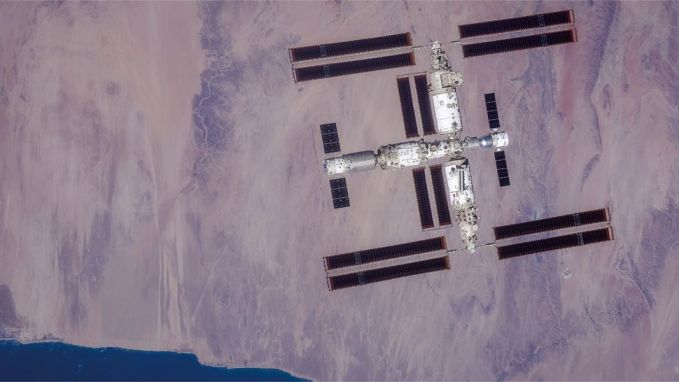
Chinese space station Tiangong, view of the Shenzhou-16 crew after leaving the station. CMSE
The crew of Tiangong 16, the fifth crew to inhabit the space station, continued scientific research conducted aboard the space station by performing a spacewalk, growing vegetables and holding a live lecture from space, during which they demonstrated lighting a match in microgravity.
On October 4, at the 47th International Astronautical Congress in Baku, the space agency announced that it intends to expand the space station with three additional modules, bringing its total number of modules to six. In addition to this, CMSA intends to send a certain company to Tiangong in the form of a Hubble-class space telescope called Xuntian, which will orbit the Earth near the space station and will be able to rendezvous with it for repairs, refueling and repairs and upgrades.
The three-module Chinese space station hosts many scientific experiments. China’s Tiangong space station orbits Earth at an altitude of 217 to 280 miles (340 to 450 kilometers), roughly the same altitude as the International Space Station (ISS).
The China Manned Space Agency (CMSA) built Tiangong – meaning “Sky Palace” – in low Earth orbit, launching each of the three modules that make up the station between 2021 and 2022. CMSA launched “Tianhe”, the station’s first module, on April 28, 2021, the second Wentian module on July 24, 2022, and the third Mengtian module on October 31, 2022.
CMSA hopes to have at least three astronauts permanently living on Tiangong for at least ten years. At this site, the space station will conduct many experiments from both China and other countries.

Chinese space station Tiangong, view of the Shenzhou-16 crew after leaving the station. CMSE
China has been excluded from the ISS program, largely due to U.S. concerns about Chinese space programs’ ties to the People’s Liberation Army, the military arm of the ruling Communist Party. In 2011, Congress prohibited NASA from significantly cooperating with its Chinese counterpart without prior approval. This law, known as the Wolf Amendment, makes it very difficult for China to participate in the ISS program, if the country wants to do so at all.
China is not a partner of the ISS, and no Chinese astronaut has ever visited this venerable outpost. Thus, the only option for the country to operate beyond Earth was to build its own space station.
Tiangong is much smaller than the International Space Station, with only three modules compared to the 16 modules on the ISS. Tiangong is also significantly lighter than the ISS, which weighs about 400 tons (450 metric tons); the scale of the Chinese station is about 20% of the ISS.
The 54-foot (16.6-meter) Tianhe module was launched with a docking port that allows it to accept the Shenzhou crew and the Tianzhou cargo spacecraft. A large robotic arm helped position the Mengtian and Wentian modules and assisted astronauts during spacewalks.
Tianhe is much larger than the Tiangong-1 and Tiangong-2 space test labs that China launched in the last decade, and is nearly three times heavier at 24 tons (22 metric tons). The new Tiangong, combined with visits to Shenzhou and Tianzhou, provides Chinese astronauts with a huge amount of usable space. Indeed, its occupants will feel as if “they will be living in a villa” compared to how little space was available in China’s previous space labs, Bai Linhou, the space station’s deputy chief designer, told CCTV back in June 2021.
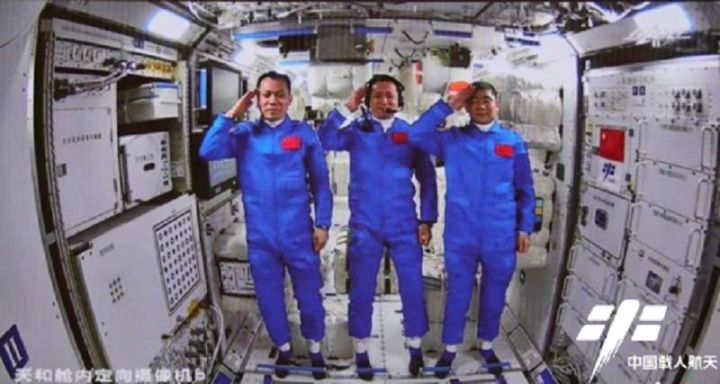
The crew of China’s Shenzhou 12 mission salutes to take a photo inside the Tianhe core module of the Tiangong space station after successfully docking with the module on June 17, 2021. CMSE
Tianhe is equipped with a regenerative life support system, including a way to recycle urine, allowing astronauts to remain in orbit for long periods of time. It is the primary habitat for astronauts and also houses the propulsion systems needed to keep the space station in orbit.
The space station could potentially be expanded to six modules if all goes according to plan. “In the future, we may expand our current three-module space station combination to a four-module cross-shaped combination,” Bai told CCTV. The second core module of Tianhe will be able to allow two more modules to join the orbital outpost.
Tiangong’s path to orbit was long. The project was first approved in 1992, after which the country began developing the Shenzhou manned spacecraft and the Long March 2F rocket to send astronauts into space. Yang Liwei became the first Chinese astronaut to fly into space in October 2003, making China the third country in the world to independently send people into orbit.
China had expressed interest in joining the International Space Station partners, but that opportunity was ended by a 2011 executive order passed by U.S. lawmakers that effectively banned NASA from directly coordinating with China or any Chinese company. This means that direct cooperation between NASA and Chinese space stations is strictly prohibited, making the prospect of sending American astronauts to Tiangong (or Chinese astronauts to the ISS) virtually impossible.

Tiangong is an active Chinese space station located in low Earth orbit. Getty Images
To be able to build and operate a manned space station, China first needed to test the space station’s critical systems, including life support and spacecraft rendezvous and docking technologies in orbit while traveling at 17,448 mph (28,080 km/h). To achieve this, China launched the 9-ton (8.2 metric tons) Tiangong-1 space laboratory in 2011, and then sent the unmanned Shenzhou-8 and then the manned Shenzhou-9 and 10 to join the ” Tiangong-1″ in orbit.
The upgraded but similarly sized Tiangong 2 launched in 2016 and hosted Shenzhou 11’s two-astronaut crew for just over a month, setting a new national record for the longest human spaceflight.
While the China Manned Space Agency verified these initial milestones, the agency was also focused on developing new, larger, heavy-duty Long March rockets that would make the space station possible. Long March 5B was designed specifically to launch the space station’s huge modules into low Earth orbit. The same rocket was the source of one of the largest uncontrolled falls in recent decades after the launch of Tianhe in late April 2021. The launches of Mengtian and Wentian were followed by similar uncontrolled downfalls of Long March 5B, which drew additional criticism from the United States and other countries.
In 2014, China completed construction of a new coastal launch site in Wenchang specifically to launch larger diameter rockets that need to be transported by sea.
China sent human bone cells to the Tiangong space station. The experiment will examine bone loss observed on Earth and in space.
The Tianzhou 7 cargo spacecraft was launched by a Long March 7 rocket from the Wenchang Satellite Launch Center on January 17 and reached the Tiangong space station just over three hours later. Among the approximately 12,350 pounds (5,600 kg) cargo were more than 60 experiments, including human bone cells to study bone mineral density.
The cells grow quickly, meaning the experiment had to be run just a few hours before launch to ensure optimal cell activity before they fill the space available to them. Their growth will be closely monitored and the data transmitted back to Earth for analysis.
“Our experimental equipment in space will guarantee the physical and chemical conditions for cell culture, such as the replacement of nutrient liquid and gas for bone cells,” Shan Peng, a professor at Northwestern Polytechnic University, told CCTV.

Chinese astronauts train at China’s Tiangong space station. CCTV
“It is also equipped with a fluorescence microscope and a conventional light microscope to observe cell growth. Some of this information will be recorded and transmitted to Earth for real-time and future analysis.”
Astronauts in orbit are advised to exercise for several hours each day to prevent bone loss associated with long-term living in microgravity.
“This will help train their skeletal muscles and also effectively prevent bone loss,” Shan said.
Research like this, also conducted in collaboration with scientists from other countries, could lead to better ways to address the bone loss problems faced both on Earth and in space.
“We will carry out further projects during the operation phase of the Chinese space station. Based on them, we will develop appropriate drugs and test them. They will help not only taikonauts in space, but also people on Earth, especially the elderly. very significant,” said Wang Jinfu, a professor at Zhejiang University in eastern China.
The Tiangong space station’s operational phase, with the Tianhe core module recently completing 1,000 days in orbit, means more and regular opportunities for China’s scientific community to conduct scientific experiments in space.
Taikonauts on Tiangong
Chinese astronauts repaired the solar wing of the Tiangong space station during an 8-hour spacewalk. This was the second spacewalk of the ongoing Shenzhou 17 manned mission at China’s Tiangong space station. The Shenzhou-17 mission launched at the end of October 2023. They made their first spacewalk in December.
Astronaut Jiang Xinlin opened the space hatch of the Wentian Experimental Module at 4:40 pm EST on March 1 (21:40 GMT; or 5:40 am Beijing time on March 2), and was joined by the mission commander outside Tiangong. Tang Hongbo. The third Shenzhou 17 crew member, Tang Shengjie, remained inside Tiangong to support operations using the space station’s robotic arm.
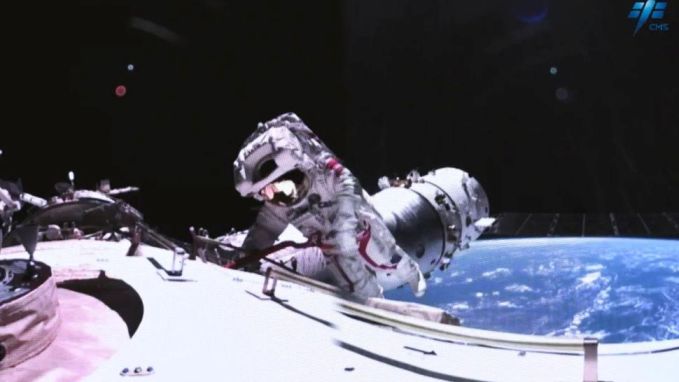
Shenzhou 17 astronauts perform a spacewalk to install solar panels on the Tiangong space station on March 1, 2024. CMSA
The main purpose of the mission was to maintain the solar array of Tiangong’s Tianhe Core Module. These large area solar panels are occasionally exposed to micrometeoroids. The pair began off-ship testing tasks after confirming that repairs to the solar array resulted in normal power production.
China sent three astronauts, the seventh crew, to the Tiangong space station as part of the Shenzhou 18 mission on April 25, 2024. The tasks of the new crew members will include spacewalks, experiments and public lectures.
The Long March 2F rocket blasted off from the Jiuquan Satellite Launch Center in the Gobi Desert on April 25 at 8:59 a.m. Eastern Time (12:59 GMT or 8:59 p.m. Beijing Time). The rocket launched the Shenzhou-18 spacecraft and its crew of three into orbit. The Shenzhou spacecraft separated from its launch vehicle 10 minutes into its flight and China’s National Space Administration declared the launch a success.

Chinese space mission Shenzhou 18 (LR) astronauts Li Guangsu, Li Cong and Ye Guangfu wave during the departure ceremony before boarding the bus that will take them to the Shenzhou 18 spacecraft at the Jiuquan Satellite Launch Center in Gobi Desert in northwestern China. April 25, 2024 GREG BAKER/AFP/Getty Images
Shenzhou 18 is commanded by Ye Guangfu, 43, who participated in the Shenzhou 13 mission in 2021-2022. The rest of the crew are fighter pilots Li Kong, 34, and Li Guangsu, 36, both new to spaceflight. All three will spend about six months in space.
“The first space flight for me was full of excitement as I realized my dream, as well as curiosity and expectation, while this space flight is more like a mission – responsibility, challenge and duty,” Ye said before the launch.
The Shenzhou 18 crew will take part in a number of activities, including a spacewalk or spacewalk, science lectures for schoolchildren observing what is happening in China, and a series of cargo and science experiments.

The Long March 2F rocket will carry three astronauts of the Shenzhou 18 mission to the Tiangong space station on April 25, 2024. CCTV+
Supplies for the mission were delivered by the robotic cargo spacecraft Tianzhou 7 in January. The crew will meet Tianzhou 8 at Tiangong around August, when the new spacecraft will deliver fresh materials, equipment and experiments.
Meanwhile, in Jiuquan, the new ship “Long March 2F”, intended to launch the Shenzhou 19 mission later this year, will be in a state of near readiness, so it can be prepared for launch as soon as possible as a lifeboat in case of a disaster or emergency.
China began construction of its Tiangong space station in 2021, with construction of the T-shaped, three-module facility completed in late 2022. Since then, it has hosted crews of three astronauts for six months.
China’s lunar missions
The capsule of the Chinese Chang’e-5 mission landed on Earth with the first new moon samples in 44 years. For the first time in more than four decades, humanity has brought moon rocks to Earth.
A capsule containing lunar dirt and gravel landed in Inner Mongolia on December 16, 2020 at 12:59 pm EST (17:59 GMT), ending China’s historic Chang’e 5 mission.
The last such delivery to the Moon was thanks to the Soviet Luna 24 mission, which returned about 6 ounces (170 grams) of material in 1976. Chang’e 5’s catch should have been much larger—about 4.4 pounds (2 kilograms)—if everything had gone according to plan on the lunar surface.
The Chang’e 5 mission, China’s first ever sample return attempt, launched on November 23, 2020, and arrived in lunar orbit five days later. Two of the four modules, the lander and its attached lander, landed on December 1 near Mons Rümker, a volcanic mountain in the vast lunar region Oceanus Procellarum (“Ocean of Storms”).
The solar-powered lander was equipped with cameras, ground penetrating radar and an imaging spectrometer to measure its surroundings. But the lander’s main job was to collect samples, which it busily did over the next two days, collecting materials from the surface and up to 6.5 feet (2 meters) underground.
On December 3, this lunar material was launched aboard the spacecraft, which on December 5 rendezvoused with the other two modules of Chang’e 5 – the orbiter and the return capsule – in lunar orbit, which stopped working on December 3, but this was not a great loss.
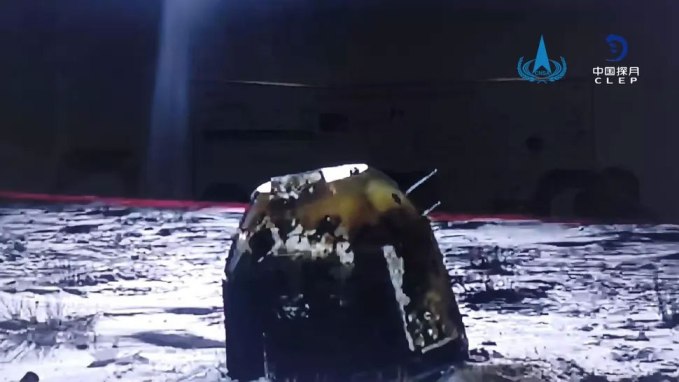
China’s Chang’e 5 sample return capsule has returned to Earth after delivering the first new samples of lunar rocks in 44 years. The landing occurred at 1:59 a.m. on December 17 Beijing time in the Siziwan Banner area in Inner Mongolia. Chinese lunar exploration project
Chang’e 5 was the final mission in the Chang’e robotic lunar exploration program, named after the moon goddess in Chinese mythology. Chang’e 1 and Chang’e 2 lifted lunar orbiters in 2007 and 2010, respectively, and Chang’e 3 landed a lander-rover duo on the near surface of the Moon in December 2013.
Next up was Chang’e 5 T1, which launched a prototype return capsule around the Moon in October 2014 to help prepare for landing. This was followed by Chang’e 4, which in January 2019 made the first ever soft landing on the mysterious far side of the Moon. This landing, as in the case of Chang’e-3, involved a pair of lander and all-terrain vehicle.
The Chang’e 4 lander and rover are still operational. Given the apparent success of Chang’e 5 (mission teams still have to inspect and evaluate the returned sample), China became only the third country to return lunar material to Earth. The other two were the Soviet Union and the United States, which brought home about 842 pounds. (382 kg) of moon rocks and dirt from six Apollo missions between 1969 and 1972.
According to scientists, the Chang’e-5 samples should open a new window into the history and evolution of the Moon, given that the rocks in the Mons Rümker region are believed to have formed only 1.2 billion years ago or so.
“All of the volcanic rocks collected by Apollo were older than 3 billion years. And all of the young impact craters whose age was determined based on analysis of the samples are younger than 1 billion years,” Bradley Jolliffe, a planetary scientist at Washington University in St. Louis, said in the report.
“Chang’e 5 samples will therefore fill a critical gap,” Jolliffe said. “These samples will be a real treasure!”
Chinese samples from the moon Chang’e-5 contain a “mysterious combination” of minerals. Old and new minerals discovered in lunar samples brought home by China’s Chang’e 5 mission are helping scientists better understand the Moon’s history.
In 2020, Chang’e 5 returned 3.8 pounds (1.73 kilograms) of rocks and dust from the Oceanus Procellarum (Ocean of Storms), the largest dark region on the Moon, visible on its western edge. Analysis of these samples revealed a new mineral called changesite-(Y), the scientists reported in a paper published on February 6, 2024. Changesite-(Y) was discovered by researchers at the Beijing Research Institute of Uranium Geology (BRIUG) and is the sixth new lunar mineral discovered.
The Moon is littered with asteroid impact craters that were left as is due to the lack of an atmosphere and geological activity on the Moon. Intense pressure and temperature from asteroid impacts are changing the composition of the moon’s top layer of rock and dust, called regolith, which scientists are studying to piece together the moon’s tumultuous history.
“Change Site-(Y)” must have been created by one such asteroid impact, which computer models estimate likely left a crater between 1.9 and 20 miles (3 and 32 kilometers) wide depending on the angle. blow. Previous analysis put the moon rocks returned by Chang’e 5 at 1.97 billion years old.

The return capsule of China’s Chang-5 spacecraft carrying lunar samples is seen after landing in Inner Mongolia, China, December 17, 2020. CASC
The returned samples of Chang’e-5 also contain a mixture of previously known silica minerals, most notably zeifertite and stishovite. Scientists believe the two minerals were likely formed by the collision that created Aristarchus Crater, the youngest of four impact craters from which ejecta struck the Oceanus Procellarum region visited by Chang’e 5.
Seifertite is known to transform into stishovite during high-pressure tremors from an asteroid impact, but there is still much to be learned about these minerals on the Moon.
“Although the lunar surface is covered with tens of thousands of impact craters, high-pressure minerals are rarely found in lunar samples,” study co-author Wei Du of the Chinese Academy of Sciences said in a statement. “One possible explanation for this is that most high-pressure minerals are unstable at high temperatures.”
In theory, seifertite and stishovite are only able to coexist at much higher pressures than apparently observed in the sample, so their presence in the returned Chang’e-5 sample is a “mysterious combination,” the scientists say.
The new research was described in an article in the journal Matter and Radiation at Extremes.
China launched the Chang’e-6 probe to return soil from the far side of the Moon. The Chinese Long March 5 Y8 launch vehicle launched from the Wenchang Satellite Launch Center.
The Chinese Long March 5 Y8 launch vehicle launched on May 3, 2024 from the Wenchang Cosmodrome on Hainan Island with the Chang’e-6 lunar probe, RIA Novosti correspondent reports. The launch took place according to schedule at 17.27 local time (12.27 Moscow time), if the mission is successful, the Chang’e-6 apparatus will for the first time in human history deliver soil to Earth from the far side of the Moon.
Chang’e-6 consists of an orbital module, a return module, a lander and a take-off module, and the probe is equipped with a payload including a landing camera, a panoramic camera, a mineral spectral analysis instrument and a lunar soil structure analysis instrument. However, Chang’e-6 is equipped with an international payload, in particular, the French DORN detector for measuring the concentration of radon gas and its decay products on the surface of the Earth’s natural satellite, the NILS negative ion analyzer from the European Space Agency, the Italian laser corner reflector and the Pakistani ICUBE-Q satellite.
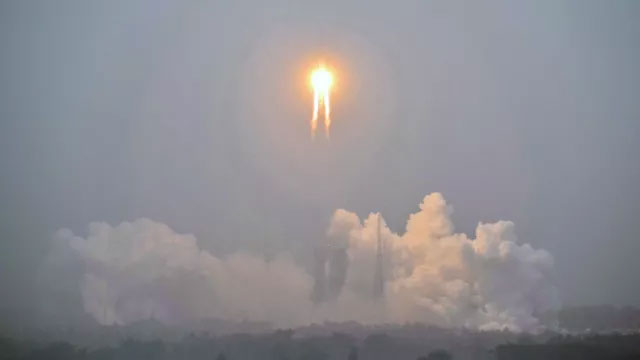
“The geological age of lunar samples collected previously by the United States and the former Soviet Union is approximately 3 billion years. The geological age of the samples collected by our Chang’e 5 mission in 2020 is approximately 2 billion years. We expect the geological age of the samples collected by the Chang’e 6 mission to be about 4 billion years old,” Ge Ping said.
The mission will last 53 days, it is planned to deliver about 2 kilograms of soil. He emphasized that all the samples studied so far were collected on the visible side of the Moon, and its far side is more ancient.
“We believe that collecting samples of lunar soil of different geological ages from different areas of the Moon and conducting laboratory research is of great value and importance in order for all humanity to have a more complete understanding of the Moon and a deep understanding of the history of the formation and evolution of the Moon – and even the origin of the Solar systems,” noted Ge Ping.
At the same time, he emphasized that the main goal of the Chang’e-6 probe mission is to deliver samples from the far side of the Moon; there have been no such precedents in the world, and he expressed hope that this mission “will bring great scientific value not only to China, but also to to all humanity.”
The South Pole-Aitken basin was chosen as the landing zone for the probe – this is an impact basin in the south of the far side of the Moon, and at the same time the largest known crater of the Moon with a diameter of 2.4 thousand kilometers.
Next year, China will launch giant reusable rockets to prepare for a human mission to the moon. China’s new giant reusable rockets are part of the country’s plans to send people to the moon by 2030. China plans to launch two reusable rockets in 2025 and 2026 in preparation for future manned missions to the Moon.
The upcoming launches are part of a new lunar program unveiled by the state-owned China Aerospace Science and Technology Corporation (CASC), the main contractor of China’s space program, which will be “key” to China’s goal of sending astronauts to the Moon by 2030, SpaceNews reports.
Unlike the missiles China has used in the past, this pair will be completely reusable. This means that they will not only be more sustainable, but also more cost-effective since they will not have to be built from scratch for future missions.

The Smart Dragon 3 launch vehicle will take off from China on February 3. Visual China Group via Getty Images
The missiles, which CASC did not name, include a 13-foot (4-meter) diameter missile and a 16-foot (5-meter) diameter missile. The larger rocket could be a variant of the planned Long March 10, a 302-foot (92 m) launch vehicle capable of sending 27 tons to translunar orbit, SpaceNews speculated. Long March 10 will also be responsible for sending the crew of the recently announced Mengzhou spacecraft to the Moon in 2030.
The potential Great March 10 test launch could place a next-generation crew capsule into Earth orbit as early as 2025, matching the recently announced reusable rocket schedule, SpaceNews added. Details about the second reusable spacecraft and launch in 2026 have not yet been disclosed.
While several Chinese companies are currently developing reusable rockets, the state-owned CASC’s new launch vehicles will “significantly expand China’s launch and space access capabilities,” competing with the country’s various commercial rocket companies, SpaceNews reports.
Ahead of a potential launch next year, CASC has successfully “completed vertical takeoff and hover landing testing” and “achieved a key technology breakthrough in reusable rockets” in 2023, Science and Technology Daily reports.
Russia and China have announced plans to build a shared nuclear reactor on the Moon by 2035 “without humans.” The proposed nuclear reactor would power the lunar base that Russia and China have agreed to build together.
The Russian space agency Roscosmos has announced plans to collaborate with China to build an automatic nuclear reactor on the Moon by 2035. The proposed reactor would help power the proposed lunar base, which both countries would jointly operate.
Back in 2021, Roscosmos and the China National Space Administration (CNSA) announced that they intended to build a common base on the Moon called the International Lunar Research Station (ILRS), which they then claimed would be “open to all interested countries and international partners.” “

CNSA’s Chang’e 5 lunar module planted the Chinese flag on the lunar surface in 2020. CNSA/CLEP
However, NASA astronauts are unlikely to be allowed to visit the base due to historically frosty relations with the CNSA and a recent split with Roscosmos, which will leave the International Space Station by 2025 in response to US sanctions over Russia’s February 2022 invasion of Ukraine .
On Tuesday (March 5), Roscosmos announced that it would eventually try to build a nuclear reactor with CNSA that could theoretically power the ILRS.
“Today we are seriously considering a project – somewhere around the turn of 2033-2035 – to deliver and install a power unit on the surface of the Moon together with our Chinese colleagues,” Roscosmos CEO Yuri Borisov told the Russian state news site.
Borisov added that complex construction work will most likely be carried out autonomously “without the presence of people” and that the necessary technological solutions for its implementation are “almost ready.”
Roscosmos also plans to use massive nuclear-powered rockets to carry cargo to the moon to build that base, but the agency has not yet figured out how to safely build those spacecraft, Reuters reports.
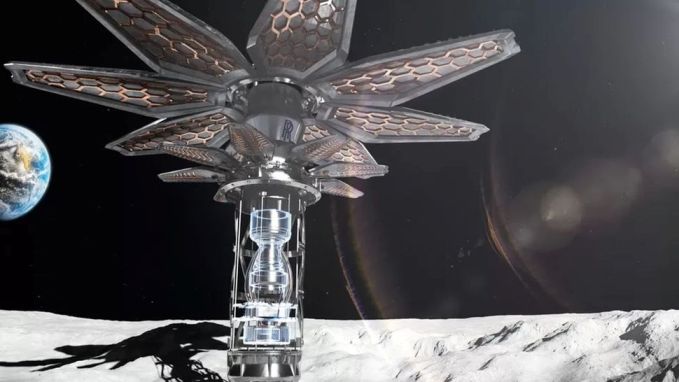
British scientists recently unveiled a design for a compact lunar nuclear reactor that NASA is considering for future missions. Rolls-Royce
A nuclear reactor or similar source of reliable energy will likely be needed to support future lunar bases, since solar panels are unlikely to generate and store enough energy.
Last September, British scientists unveiled plans for a compact nuclear reactor that could be powered by tiny fuel cells the size of a gas station and would be tested by NASA for future missions. It is currently unclear what size and shape the joint Russian-Chinese reactor will take.
X-ray lobster eye – Einstein probe
The Chinese Academy of Sciences (CAS) Einstein Probe spacecraft was launched on January 9, 2024. Equipped with next-generation X-ray instruments with high sensitivity and a very wide field of view, this mission will survey the skies and hunt for powerful explosions. X-ray light comes from mysterious celestial objects such as neutron stars and black holes.
The Einstein Probe is a collaboration between CAS and the European Space Agency (ESA) and the Max Planck Institute for Extraterrestrial Physics (MPE), Germany. In exchange for contributing to the development of this mission and defining its scientific goals, ESA will have access to 10% of the data obtained from Einstein observations.
“Thanks to its innovative design, the Einstein probe can observe large areas of the sky at a glance. In this way, we will be able to detect many new sources and at the same time study the behavior of X-ray light coming from known celestial objects over long periods of time,” says Erik Kuulkers, ESA project scientist for the Einstein Probe. “Space is our only laboratory for studying the most energetic processes. Missions like the Einstein Probe are needed to improve our understanding of these processes and study fundamental aspects of high-energy physics.”
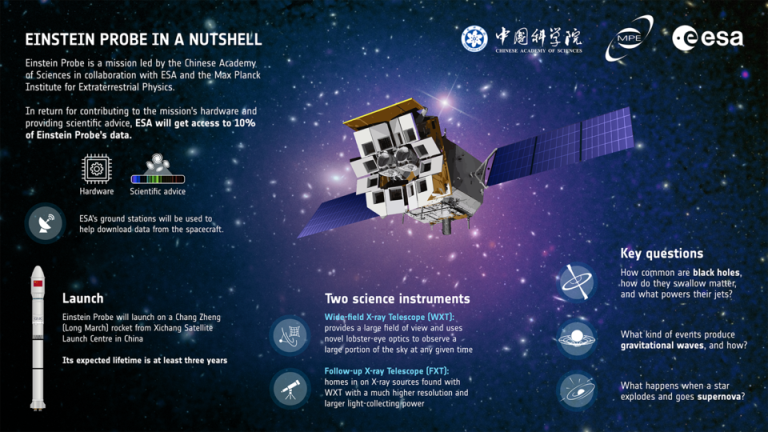
Briefly about the Einstein probe
Unlike the stars that dot our skies at night and reliably mark constellations, most cosmic objects that shine in X-rays are highly variable. They constantly brighten and dim, and in many cases they appear briefly and then disappear for long periods of time (then called transients) or forever.
X-ray light from astronomical sources caused by violent cosmic events is highly unpredictable. However, it carries fundamental information about some of the most mysterious objects and phenomena in our Universe. X-rays are associated with neutron star collisions, supernova explosions, matter falling into black holes or superdense stars, and the ejection of high-energy particles from disks of blazing material orbiting such exotic and mysterious objects.

Supernova Puppis A. Chinese Academy of Sciences
The Einstein probe will improve understanding of these cosmic events by detecting new sources and tracking the variability of X-ray objects across the sky.
The ability to regularly detect new sources of X-ray radiation is fundamental to understanding the origin of gravitational waves. When two super-dense massive objects, such as two neutron stars or black holes, collide, they create waves in the fabric of space-time that travel across cosmic distances and reach us. Several detectors on Earth can now detect this signal, but often fail to identify the source. When it comes to neutron stars, such a “cosmic collapse” is accompanied by a huge release of energy across the entire light spectrum, and especially in X-rays. By allowing scientists to quickly study these short-lived events, the Einstein Probe will help us determine the origin of many of the gravitational wave pulses observed on Earth.

Panoramic image of the Milky Way in X-rays. EPSC/NAO–CAS/DSS/ESO
To achieve all its scientific goals, the Einstein Probe spacecraft is equipped with a new generation of instruments with high sensitivity and the ability to observe large areas of the sky: the Wide Field X-ray Telescope (WXT) and the observation telescope – the X-ray Telescope (FXT).
The WXT features an optical modular design that mimics lobster eyes and uses innovative Micro Pore Optics technology. This allows the instrument to observe 3,600 square degrees (almost one-tenth of the celestial sphere) in a single image. Thanks to this unique capability, the Einstein probe can closely monitor almost the entire night sky as it orbits the Earth three times (each orbit takes 96 minutes).
New X-ray sources or other interesting events detected by WXT are then identified and studied in detail using the more sensitive FXT. Importantly, the spacecraft will also transmit an alert signal to the ground to activate other telescopes on Earth and in space operating at other wavelengths (ranging from radio to gamma rays). They will quickly point to a new source for collecting valuable multi-wavelength data, allowing for a more thorough study of the event.

Assembling the Einstein Probe
ESA played an important role in the development of the scientific instruments of the Einstein Probe. He provided testing and calibration support for WXT X-ray detectors and optics. ESA developed the mirror assembly of one of the two FXT telescopes in collaboration with MPE and Media Lario (Italy). The FXT mirror node is based on the design and technology of ESA’s XMM-Newton mission and the eROSITA X-ray telescope. MPE provided mirror assemblies for another FXT telescope and developed detector modules for both FXT devices. ESA also provided a system to deflect unwanted electrons from the detectors (electron rejector).
Throughout the mission, ESA ground stations will be used to download data from the spacecraft. XMM-Newton and Integral have been studying the Universe using X-rays and gamma rays for more than two decades, leading to significant advances in the field. ESA is also participating in the X-ray Imaging and Spectroscopy Mission (XRISM), led by the Japan Aerospace Exploration Agency (JAXA) in collaboration with NASA, which launched in summer 2023.
The problem with X-rays is that their energy is so high that they are difficult to detect with a standard detector. Lenses don’t work because X-rays are too strong to bend easily. X-rays can only be detected when they strike a reflective surface at a slight angle. From there they must be sent to a special X-ray detector.
Scientists were inspired to solve the problem by the eyes of lobsters. Human ones operate on the principle of refraction through the lens. Lobster eyes, on the other hand, are a collection of tiny tubes arranged in parallel square pores on the surface of the eyes. Each of them is directed in a different direction. Light enters the tubes and is reflected onto the retina.
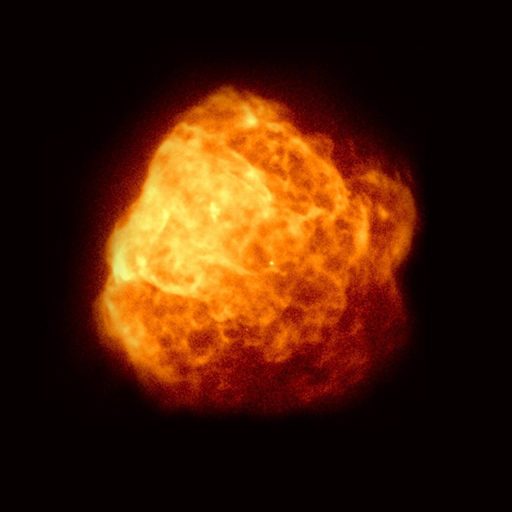
Globular cluster Omega Centauri. Chinese Academy of Sciences
And while human vision covers a field of view of about 120 degrees, lobsters have a panoramic field of vision of 180 degrees. During its operation, the Einstein probe managed to photograph several impressive and rare objects. For example, the globular cluster Omega Centauri. X-rays are emitted from binary systems where star material accretes onto a neutron star or black hole.
Satellites of China
During the period from 1970 to 2010, China built 147 satellites for its needs and 6 satellites for other countries. Of the 147 satellites, 138 were successfully launched into orbit. The reliability of a successful satellite launch in China over the entire period is 93.9%, which exceeds the reliability of Russian and US launch vehicles. In addition, China purchased nine satellites from European and American manufacturers. As of December 31, 2010, China’s orbital constellation included 69 spacecraft.
China has built a space-based direct television broadcast system and satellites to broadcast educational programs. The PRC has created a system of satellites for remote sensing of the Earth’s surface (ERS), including a network of geostationary and low-orbit meteorological satellites. China is successfully implementing plans to explore the Moon by launching a return vehicle and delivering lunar rock to the earth. China entered the international space launch services market about 20 years ago. But a number of accidents occurred during satellite launches between 1992 and 1996, and China left the launch services market for 12 years. At the end of the first decade of the 21st century, China successfully returned to the international space market, but with a comprehensive service that included developing satellites, delivering them into orbit, and financing projects.
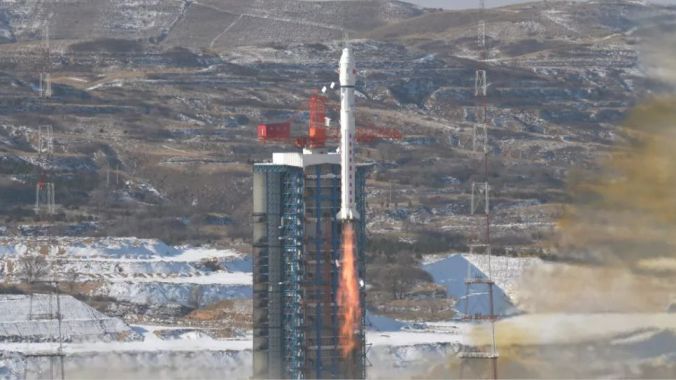
The Chinese Long March 2D rocket launched four satellites into orbit from the Taiyun Satellite Launch Center on January 15, 2020, two for China and two for the Argentine company Satellogic. China Aerospace Science and Technology Corporation
China has already begun to lead the world in military launches, sending 45 defense satellites into orbit in 2022. This is 15 more than the US. Although the People’s Liberation Army’s (PLA) space plans have not been disclosed, its actions make it clear that China has found its way into space and plans to stay there.
China’s growing presence in the “last frontier” is part of an awakening to the importance of space. The basics are not new. In 1970, UNESCO noted the importance of space exploration, and China is one of a growing number of countries recognizing the enormous economic, strategic, military and political potential of space activities. The annual number of payloads launched into orbit has grown tenfold over the past decade, and the global space economy is valued at $469 billion, with annual space revenues 6.4% higher in 2022 than in 2021.
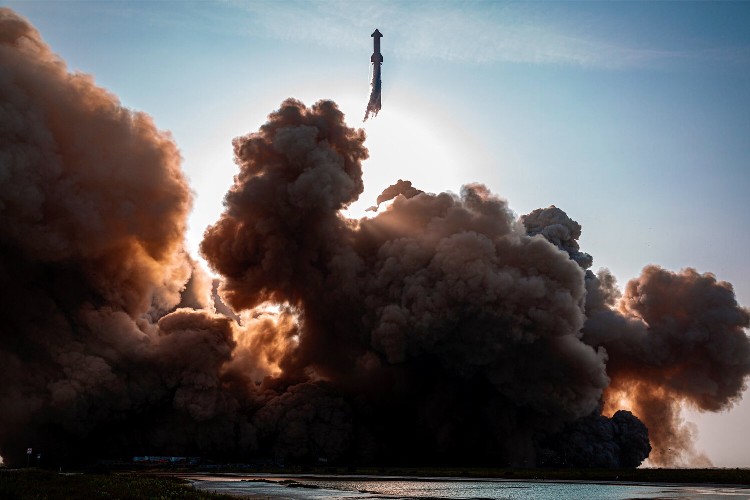
China’s rapid growth in space capabilities has included its own positioning and navigation system, the BeiDou satellite system, which Chen Gukang, deputy director of the China Satellite Navigation Administration, considers comparable to GPS, if not better.
In 2007, China conducted an anti-satellite test, blowing up one of its old weather satellites and creating a cloud of space debris that persists to this day. NASA astronaut Leroy Jiao, an expert on China’s space program, called the event an act of defiance of U.S. efforts to reserve the right to deny access to space to anyone deemed a threat. Although this action was condemned worldwide at the time, it revealed the extent of the PLA’s counter-space capabilities and its efforts to militarize space alongside the United States.
In February 2024, China launched the world’s first commercial artificial intelligence satellite. It was developed by Guoxing Aerospace. The device is designed to test the Synaesthesia Fusion AI algorithm in orbit. At the same time, the Chinese Geely launched 11 satellites into orbit for its self-driving cars.
According to it, the Smart Dragon-3 (SD-3) launch vehicle took off from the sea at 11:06 Beijing time (06:06 Moscow time) off the coast of Yangjiang in southern China. There were a total of nine satellites on board. The SD-3 is a solid-fuel launch vehicle developed by the China Rocketry Research Institute and intended for the commercial market, Xinhua notes. It can be launched from both land and sea. Saturday’s launch marked the third use of this type of rocket.
According to CGTN, the Rongpiao commercial artificial intelligence satellite that was on board the SD-3 was developed by Guoxing Aerospace based in Chengdu, Sichuan Province. It is an integrated sensing network satellite and will be used to test the Synaesthesia Fusion artificial intelligence algorithm in orbit, the TV channel indicated.
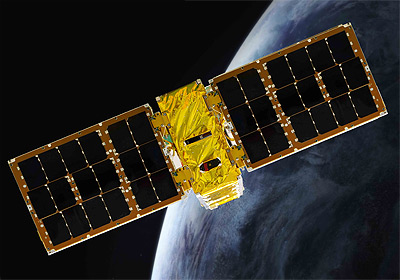
At the same time, the Chinese automaker Geely launched 11 low-orbit satellites into space designed to improve the navigation of its unmanned vehicles, Reuters reports, citing a company statement. The satellites were launched from the Xichang Satellite Launch Center in southwest China.
Geely noted that the satellites have a remote sensing function using artificial intelligence. The automaker assured that by 2025, 72 of the company’s satellites will be operating in orbit, and in the future it is planned to create a network of 240 satellites.
A Chinese company has launched 5 Earth remote sensing satellites into orbit. A phased array radar satellite was among the passengers on the Kinetica-1 launch on January 22.
The third solid rocket, Kinetica-1, lifted off from the Jiuquan Satellite Launch Center in northwest China at 11:03 pm EST on Monday, January 22; 04:03 GMT and 12:03 Beijing time on January 23.
On board were five Taijing satellites, all designed and built by Beijing-based private satellite manufacturer Minospace. The Taijing-1C, 2B, 2D, 3B and 4C satellites are remote sensing satellites for various purposes. According to CAS Space, the first four are optical remote sensing satellites, and Taijing-4C is a phased array synthetic aperture radar satellite operating in the Ku-band of the electromagnetic spectrum.
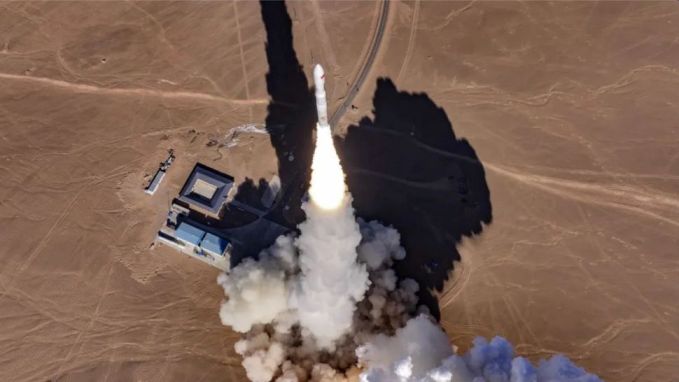
CAS Space’s third Kinetica-1 rocket will launch from the Jiuquan Satellite Launch Center on January 22, 2024. CAS Space
The rocket was developed by Beijing-based commercial launch service provider CAS Space under the auspices of the state-run Chinese Academy of Sciences (CAS).
Kinetics-1 (also known as Lijian-1) is a four-stage solid-propellant rocket that stands 98 feet (30 meters) tall and is capable of lifting a 3,300-pound (1,500 kg) payload into a sun-synchronous orbit.
NASA chief says US ‘better keep an eye on’ China’s targets
NASA Administrator Bill Nelson says the United States is engaged in a space race with China that could see Beijing try to lay claim to parts of the moon.
Both China and the United States have lofty goals for lunar exploration and colonization. Both the US and China have serious lunar ambitions, with NASA working on its Artemis program to return astronauts to the Moon, while China aims to send its own crews to the Moon before the end of the decade and build a lunar base in the 2030s. Both powers are considering landing in the same areas near the lunar south pole.
“It’s a fact: We’re in a space race,” the NASA administrator told Politico in an interview. “And it’s true that we better make sure they don’t get to the moon. under the guise of scientific research, and it is quite possible that they are saying: “Don’t go, we are here, this is our territory.”
Relations between the US and China are complex and have become increasingly tense in recent years. The mistrust between the two powers is also evident in matters related to space.

NASA Administrator Bill Nelson delivers opening remarks during NASA’s inaugural Climate Summit on Thursday, Dec. 8, 2022. NASA/Keegan Barber
However, there is no legal basis for claims to territory in space. China, like the United States and 132 other countries, is a party to the 1967 Outer Space Treaty, which states that “Outer space, including the Moon and other celestial bodies, is not subject to national appropriation by claim of sovereignty, use or occupation, or any other ways.”
Nelson, however, points to China’s behavior and territorial claims in the South China Sea as a possible indicator of future claims to the Moon.
Representatives of the Chinese space industry have tried to refute Nelson’s latest statements. “We carry out spaceflight to develop high technology and improve economic growth and people’s living standards,” Yang Yuguang, a senior space industry observer in Beijing and vice chairman of the International Astronautical Federation’s space transport committee, told the state-run China Daily. “We are not participating in the space race with any other countries because competition in this regard is pointless,” Yang added.

An animation from the China Aerospace Science and Technology Corporation shows what China’s first manned lunar lander will look like on a future lunar mission with astronauts. CCTV
Nelson appeared to suggest that cooperation with China might be possible during the International Astronautical Congress in Paris in September, despite existing congressional obstacles to NASA engaging with Chinese entities. However, the former Florida senator and astronaut said China needs to be more open and transparent about its plans for space.
Wu Yansheng stated that CASC faces problems in implementing its plans due to conditions created by the US, such as “renewed great power competition”, exclusion from the International Space Station program and the addition of Chinese aerospace companies such as CASC to blacklists US exports.
Wu also said the US is seeking to seize strategic space resources, including certain orbits, locations and radio frequencies, SpaceNews reported last month. China has also previously expressed concerns about SpaceX’s megaconstellation of Starlink communications satellites.




